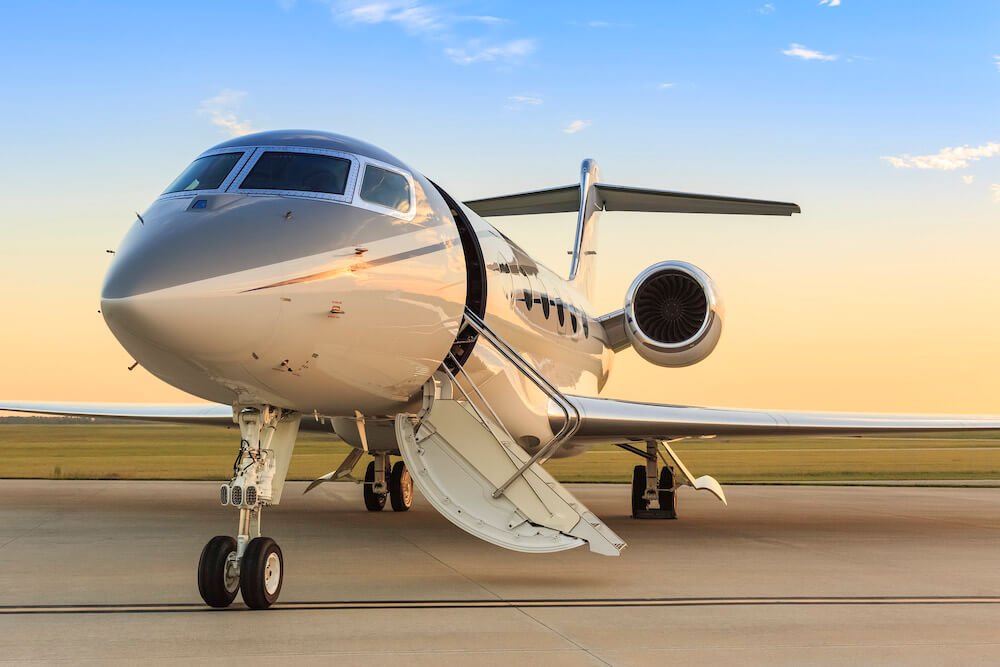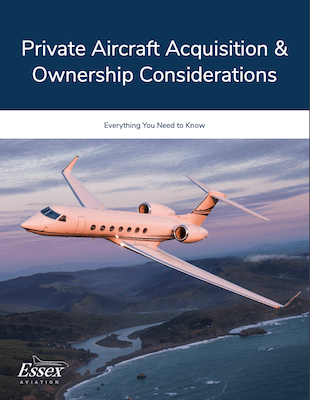
Even for high-net-worth individuals, whether to purchase a private aircraft might rank as one of the most expensive — and, potentially, lifestyle-changing — decisions they’ll ever make. From upfront costs to the ongoing costs of maintenance, hangarage and direct operating costs, private aircraft ownership requires a significant capital investment but, for those who frequently fly for business or personal reasons, it provides unparalleled travel experiences.
The fact of the matter is that the comfort, convenience, luxury and freedom that private aviation offers would be compelling to just about anyone and considered well worth the cost by those who can afford it — so let’s talk about the options to best structure it through private jet financing.
Let’s Talk Costs
Before a buyer kickstarts their search for a private aviation lender, they’ll first want to thoroughly consider the costs of purchasing a private jet. Conservative estimates place the cost of a brand-new private jet between $7 million and $75 million, while the most expensive private aircraft in the world — those of commercial size but modified for private use — cost well above that range.
For those buyers hoping to minimize their capital investment in an aircraft, acquiring a pre-owned aircraft can offer many of the same benefits as a new model with a reduced capital cost. However, for the following new aircraft, current industry data included in the VREF Aircraft Value Reference Guide offers some perspective on pricing and just how expansive the private jet financing industry is.
| Aircraft Manufacturer | Model & Retail Price in Millions (New in 2019) |
|---|---|
| Bombardier | • Lear 75: $13.8m • Challenger 650: $32.4m • Global 5000: $50.4m • Global 6000: $62.3m • Global 7500: $72.8m |
| Cessna | • Citation M2: $5m • Citation CJ3+: $8.6m • Citation CJ4: $9.6m • Citation XLS+: $13.6m • Citation Latitude: $17.3m • Citation Sovereign 680+: $18.8m |
| Embraer | • Phenom 100 EV: $4.5m • Phenom 300: $9m • Legacy 450: $16.6m • Praetor 500: $17m • Praetor 600: $21m • Legacy 650E: $26m • Lineage: $50m |
| Dassault | • Falcon 2000S: $30m • Falcon 2000LXS: $35.1m • Falcon 900LX: $44.8m • Falcon 7X: $53.8m • Falcon 8X: $59.3m |
| Gulfstream | • G500: $46.5m • G600: $57.9m • G650: $69.5m |
| Pilatus | • PC-24: $9.5m |
Choosing the Right Lender
The road to private aircraft ownership should begin with the decision to retain the services of an aviation consultant or a jet financing broker. It is the responsibility of an aviation consultant to understand the buyer’s needs and situation to direct them to an appropriate tax attorney and, ultimately viable lenders and financing structures. Once the consultant has completed these steps, the process of researching lenders, requesting and reviewing lender proposals and working with the client or the client’s team is fairly straightforward. A consultant’s primary contribution is to apply their knowledge and considerable network of industry connections to facilitate the financing solution that best serves the client’s unique needs and requirements.
High-net-worth individuals often partner with aviation consultants and finance brokers through their private wealth advisors or in-house finance team in order to identify the best options available. Clients in different segments of the market who might not have the same level of in-house financing staff to support their needs can also benefit from assembling a team of third-party experts within the private aviation industry. Whether they’re working with an in-house finance team, a third-party private aviation consultant or an aircraft finance broker to evaluate lenders, buyers have three private jet financing options from which to choose:
- Traditional Banks: For most buyers, utilizing their current bank can be the most efficient choice for jet financing due to their existing relationship. The bank already has a complete portfolio of the buyer’s finances, which can make the loan process that much more efficient.
- Banks With Aircraft Finance Groups: In the event that a buyer’s current bank cannot provide jet financing, it may still be able to use its industry connections to put the buyer in touch with a different bank that has a dedicated aircraft finance group. These institutions specifically have a vested interest in private jet financing and already manage a large aircraft portfolio and would therefore be more inclined to offer private jet financing to a buyer without an existing relationship.
- Private Lending Groups: This type of lender is able to provide private jet financing by raising capital within equity markets to support their portfolio growth. Though private aircraft lenders are less common than their traditional banking counterparts, they are a viable option for buyers who, for whatever reason, wish to avoid securing a loan with their primary bank or a traditional bank. Buyers who choose to pursue this private jet financing option are still advised to work with a private aviation consultant and tax attorney to confirm the lender’s position in the market and whether it’s a suitable option for the buyer in question.
Criteria for Private Jet Financing Evaluation
It is, understandably, in a lender’s best interest to be highly discerning about who it grants private jet financing to and how much it lends. Therefore, similar to home mortgage lenders, private aircraft lenders have strict criteria for evaluating potential borrowers, as well as additional portfolio parameters based on the age and models of aircraft they’re able to finance.
For buyers who want a better understanding of this criteria, look no further than the “5 Cs” of credit: character, capital, capacity, collateral and conditions.
- Character refers to the borrower’s reputation and the stability of their credit.
- Capital refers to the borrower’s net worth and the types of capital assets they currently own.
- Capacity refers to the borrower’s ability to pay on the loan, as well as their current debt-to-income ratio.
- Collateral refers to the assets that the borrower is able to pledge to secure the loan.
- And, finally, conditions refer to how the borrower intends to use the aircraft, as well as external factors such as pending legislation that could affect the loan and the current state of the economy.
Buyers should be aware that most lenders have specific loan covenants, and that their lender of choice might require periodic reviews of the aircraft’s market value and also organize third-party inspections to determine whether the aircraft is being kept in the proper condition.
Alternatives to Private Jet Ownership
For individuals who want to replicate the experience of owning their own aircraft without having to worry about securing private jet financing, there are multiple alternatives to outright ownership:
- Private Jet Lease: The individual leases an aircraft from the owner for a specified period of time and assumes full operational control — similar to direct ownership — without transferring the aircraft title. Private jet leasing offers similar operational benefits, which can make it a viable option for buyers who are not able to take advantage of the tax benefits that direct ownership can provide. In some cases, however, private jet leasing agreements preclude the lessee from using the aircraft for third-party charter (FAR Part 135).
- Fractional Aircraft Ownership: The individual invests in partial ownership by purchasing a share of a specific aircraft type and agrees to an annual amount of flight hours depending on their specific travel needs. Fractional ownership often comes with significant upfront acquisition and monthly operational costs, but fractional owners save on deadhead costs.
- Private Jet Membership: The individual agrees to a fixed cost per hour at the start of the contract and is billed after each flight. Members are also expected to pay monthly management or annual membership fees.
- Jet Card Program: The individual either agrees to a predetermined number of hours on a specific aircraft type or size category (dedicated service) or funds an established travel account and chooses the aircraft category on a trip-by-trip basis, after which the cost of trip is calculated and deducted from the account’s balance (debit card service).
- Private Jet Charter: The individual charters — that is, rents — an aircraft for each specific trip they wish to take. Private jet chartering can be well-suited for individuals with relatively low annual travel requirements, but who fly to areas that cannot be easily reached by scheduled airline service.
A Final Note
Buyers interested in purchasing a private jet should assemble a team of professionals to assist them at every step of the process. From sorting out aircraft-specific tax considerations to hiring an aircraft management company to handle day-to-day operations and support once the purchase is complete, buyers will want to have qualified and capable industry experts on their side — starting with a private aviation consultant.
At Essex Aviation, we have a combined 70 years of aviation experience; in that time, we’ve had the opportunity to learn the ins and outs of the private aviation industry, as well as develop strong relationships with service providers and other vendors. We’re able to leverage this knowledge and our vast network of industry connections in order to ensure that our clients’ unique private aviation requirements are met with unbiased guidance and that they have a quality client experience, from start to finish.
How can we serve your private aviation needs? Contact Essex Aviation today to let us know.







